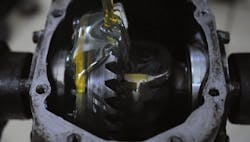Achieve robust protection from modern gearboxes
The cost of machine downtime can be astronomical in industrial plants, and facility managers are tasked with doing everything in their power to maximize uptime and reliability.
Industrial gearboxes are common assemblies found inside a wide variety of industrial environments, such as wind turbine drives, conveyer belt drives, robotics, or crusher drives. A single part failure inside a gearbox can result in complete production shutdown, lost throughput, lost revenue, and high maintenance costs. Typically, the minimum production downtime from a gearbox failure is around two to three hours. For somewhere like a steel mill, this may mean losses in production totaling in excess of $200,000 per hour. This doesn’t include labor costs, which can be excessive if outside contractors are required to make repairs. For large mills, these costs can balloon exponentially.
This scenario serves to highlight the importance of high-performance industrial gear oils (IGOs) and their ability to provide robust protection for these critical pieces of machinery. In recent years, IGOs have become even more important, with industrial markets demanding higher productivity and 24/7 operation, elevated levels of protection to ensure durability and extended gearbox life, and increased power to operate at a range of extreme temperatures.
How have IGOs managed to keep pace with these growing demands? In this article, we’ll explore the evolution of IGOs, some inherent challenges involved in modern formulation techniques, and how the right chemistries can help provide complete protection to help plants get the most from their most critical gearbox applications.
Modern machine demands
Modern industrial activity has sought efficiency gains in every aspect of regular operation—and IGOs are no different. Today, it is expected that IGOs provide longer drain intervals so that the maintenance of replacing the oils must be performed less frequently. Simultaneously, modern gearboxes have become smaller and operate hotter in order to minimize design footprint and maximize efficiency, respectively.
These needs are driving formulations toward the use of synthetic base stocks rather than traditional mineral oil base stocks. Particularly within environments that regularly experience harsh conditions (mining, marine, wind, and steel), synthetic IGO formulations can deliver extended drain intervals while providing robust protection for all elements of the gearbox, helping to lower total cost of ownership for critical equipment.
Formulating high-performance IGOs
So, how have IGOs evolved to accommodate these demands? First, it’s important to understand the fundamental performance characteristics synthetic IGO formulations must provide in today’s gearboxes:
- wear protection, helping to prevent failure modes like micropitting, cracking, and scuffing
- foam control and air release
- compatibility with non-metal components within the gearbox, including paint and seals.
These performance characteristics (and others) are codified within various stringent standards from OEMs or governmental agencies and national standards. In some cases, IGO products may need to meet more than 20 specifications, including those from major gearbox OEMs like Flender, SEW, Sumitomo, and ZF Industrial.
Performance meeting these standards is realized through the addition of chemical additives to the synthetic base stock. These additives ensure wear protection, corrosion protection, water shedding, and foam control. Large advancements in antiwear chemistries have been made in recent years to ensure gearboxes are protected robustly against a multitude of possible failure mechanisms. In order to have a stable blend of polar chemical additives in a nonpolar synthetic base oil, a compatabilizing chemistry is also incorporated. The compatabilizer must not compromise the benefits of using a high-quality base oil, high-quality additives or compromise the kind of performance that plant teams depend on.
Compatibilizer complexities
However, modern gearbox operating conditions have created some challenges to this simple-sounding recipe for high-performance IGOs. Traditional compatibilizers have been ester-based, a chemistry that has long been cost-effective and readily available while providing the right characteristics for formulating. But esters’ chemical makeup can change when in contact with water ingress (a condition faced by marine gearbox applications), which can alter the IGO’s performance. Excessive heat—a condition inherent to smaller, more efficient gearboxes—can also cause esters to change, compromising performance. Finally, esters are not always fully compatible with modern paint formulations and seal compounds.
Seal compatibility is in fact one of the biggest challenges to the use of some compatibilizers in new IGO formulations. Particularly in dynamic applications, where a shaft exits the gearbox and operates at different speeds at various intervals. At the point where the shaft exits the gearbox, a radial seal helps prevent lubricant leakage as well as ingress of contaminants from the exterior of the gearbox. The IGO must be benign to the seal, not causing any chemical breakdowns that may cause for example embrittlement, shrinkage, softening, or hardening.
Traditional ester-based compatabilizers can interact with seals in high temperature environments and cause excessive seal swell—a swollen seal, over time, will eventually act as a grinding mechanism against the shaft. This scenario will inevitably cause the sealing contact to fail, leading to costly maintenance and downtime.
Meeting the needs of modern formulation
Delivering complete IGO solutions that do not compromise on performance at any level requires new compatibilizer chemistries that enable a broad range of performance characteristics without inadvertently causing material compatibility issues in modern gearboxes. The ideal IGO formulation enables robust tribological protection of critical gearbox bearings while not interfering with the chemical composition of the seal.
For plant operators, it’s also important that compatibilizer chemistries interact with older gearbox technology—backward compatibility is important for operational efficiency. The ideal IGO formulation for modern gearbox applications enables high performance in a brand-new gearbox as well as older models, allowing plant operators to stock a single IGO for every gearbox. Importantly, this ideal IGO should further meet a broad range of OEM and national standards for the most widespread applicability and robust protection of critical gearbox components.
Armed with greater knowledge of what makes for an ideal IGO, it can behoove plant operators to work closely with their lubricants suppliers to make the most informed choice for your operations. The right formulation can help eliminate unnecessary maintenance and downtime, enhance operational efficiency, and bolster the bottom line.
This story originally appeared in the May 2022 issue of Plant Services. Subscribe to Plant Services here.
David Hobson is technology manager for industrial additives, and Daniel O’Meara is industrial OEM manager for The Lubrizol Corporation, based in Wickliffe, OH.

